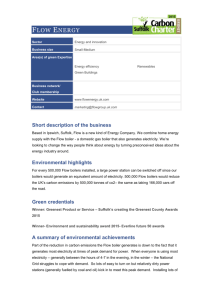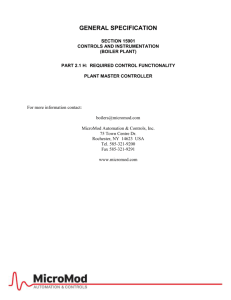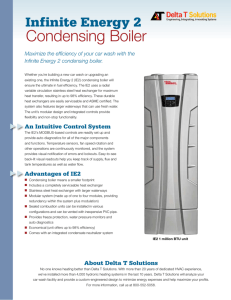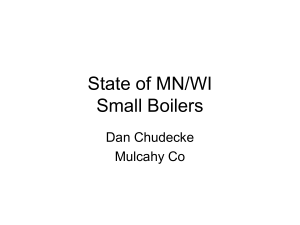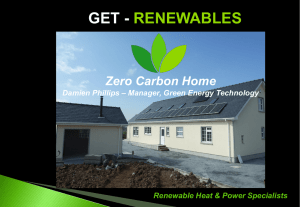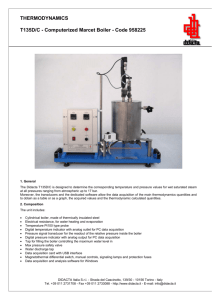1.1 related documents
advertisement
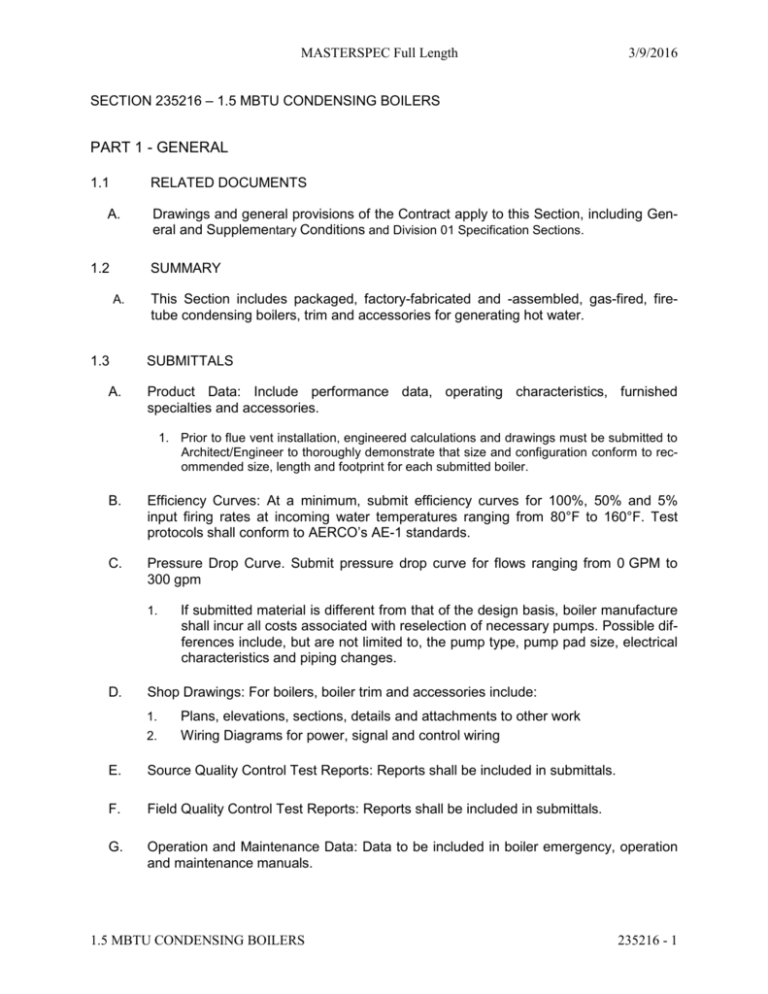
MASTERSPEC Full Length 3/9/2016 SECTION 235216 – 1.5 MBTU CONDENSING BOILERS PART 1 - GENERAL 1.1 RELATED DOCUMENTS A. 1.2 Drawings and general provisions of the Contract apply to this Section, including General and Supplementary Conditions and Division 01 Specification Sections. SUMMARY A. 1.3 A. This Section includes packaged, factory-fabricated and -assembled, gas-fired, firetube condensing boilers, trim and accessories for generating hot water. SUBMITTALS Product Data: Include performance data, operating characteristics, furnished specialties and accessories. 1. Prior to flue vent installation, engineered calculations and drawings must be submitted to Architect/Engineer to thoroughly demonstrate that size and configuration conform to recommended size, length and footprint for each submitted boiler. B. Efficiency Curves: At a minimum, submit efficiency curves for 100%, 50% and 5% input firing rates at incoming water temperatures ranging from 80°F to 160°F. Test protocols shall conform to AERCO’s AE-1 standards. C. Pressure Drop Curve. Submit pressure drop curve for flows ranging from 0 GPM to 300 gpm 1. D. If submitted material is different from that of the design basis, boiler manufacture shall incur all costs associated with reselection of necessary pumps. Possible differences include, but are not limited to, the pump type, pump pad size, electrical characteristics and piping changes. Shop Drawings: For boilers, boiler trim and accessories include: 1. 2. Plans, elevations, sections, details and attachments to other work Wiring Diagrams for power, signal and control wiring E. Source Quality Control Test Reports: Reports shall be included in submittals. F. Field Quality Control Test Reports: Reports shall be included in submittals. G. Operation and Maintenance Data: Data to be included in boiler emergency, operation and maintenance manuals. 1.5 MBTU CONDENSING BOILERS 235216 - 1 MASTERSPEC Full Length H. I. Warranty: Standard warranty specified in this Section Other Informational Submittals: 1. 1.4 3/9/2016 ASME Stamp Certification and Report: Submit "H" stamp certificate of authorization, as required by authorities having jurisdiction, and document hydrostatic testing of piping external to boiler. QUALITY ASSURANCE A. Electrical Components, Devices and Accessories: Boilers must be listed and labeled as defined in NFPA 70, Article 100, by a testing agency acceptable to authorities having jurisdiction, and marked for intended use. B. I=B=R Performance Compliance: Condensing boilers must be rated in accordance with applicable federal testing methods and verified by AHRI as capable of achieving the energy efficiency and performance ratings as tested within prescribed tolerances. C. ASME Compliance: Condensing boilers must be constructed in accordance with ASME Boiler and Pressure Vessel Code, Section IV “Heating Boilers”. D. ASHRAE/IESNA 90.1 Compliance: Boilers shall have minimum efficiency according to "Gas and Oil Fired Boilers - Minimum Efficiency Requirements." E. DOE Compliance: Minimum efficiency shall comply with 10 CFR 430, Subpart B, Appendix N, "Uniform Test Method for Measuring the Energy Consumption of Furnaces and Boilers." F. UL Compliance: Boilers must be tested for compliance with UL 795, "CommercialIndustrial Gas Heating Equipment." Boilers shall be listed and labeled by a testing agency acceptable to authorities having jurisdiction. G. NOx Emission Standards: When installed and operated in accordance with manufacturer’s instructions, condensing boilers shall comply with the NOx emission standards outlined in South Coast Air Quality Management District (SCAQMD), Rule 1146.1; and the Texas Commission on Environmental Quality (TCEQ), Title 30, Chapter 117, and Rule 117.465. 1.5 A. 1.6 A. COORDINATION Coordinate size and location of concrete bases. Cast anchor-bolt inserts into bases. Concrete, reinforcement and formwork requirements are specified in Division 03. WARRANTY Standard Warranty: Boilers shall include manufacturer's standard form in which manufacturer agrees to repair or replace components of boilers that fail in materials or workmanship within specified warranty period. 1.5 MBTU CONDENSING BOILERS 235216 - 2 MASTERSPEC Full Length 1. 3/9/2016 Warranty Period for Fire-Tube Condensing Boilers a. The pressure vessel/heat exchanger shall carry a 10-year from shipment, nonprorated, limited warranty against any failure due to condensate corrosion, thermal stress, mechanical defects or workmanship. b. Manufacturer labeled control panels are conditionally warranted against failure for (2) two years from shipment. c. All other components, with the exception of the igniter and flame detector, are conditionally guaranteed against any failure for 18 months from shipment PART 2 - PRODUCTS 2.1 MANUFACTURERS A. Available Manufacturers: Subject to compliance with requirements, manufacturers offering products that may be incorporated into the Work include, but are not limited to, the following: B. Manufacturers: Subject to compliance with requirements, provide products by one of the following: C. Basis-of-Design Product: Subject to compliance with requirements, provide AERCO International, BMK 1500 or a comparable product by one of the following: 1. 2. 3. 2.2 AERCO International Buderus Viessmann Manufacturing Co. (US) Inc. CONSTRUCTION A. Description: Boiler shall be natural gas fired, fully condensing, fire tube design. Power burner shall have full modulation (the minimum firing rate shall not exceed 75,000 BTU/HR input. Boilers that have an input greater than 75,000 BTU/Hr at minimum fire will not be considered) and discharge into a positive pressure vent. Boiler efficiency shall increase with decreasing load (output), while maintaining setpoint. Boiler shall be factory-fabricated, factory-assembled and factory-tested, fire-tube condensing boiler with heat exchanger sealed pressure-tight, built on a steel base, including insulated jacket, flue-gas vent, combustion-air intake connections, water supply, return and condensate drain connections, and controls. B. Heat Exchanger: The heat exchanger shall be constructed of 439 stainless steel fire tubes and tubesheets, with a one-pass combustion gas flow design. The fire tubes shall be 5/8” OD, with no less than 0.049” wall thickness. The upper and lower stainless steel tubesheet shall be no less than 0.25” thick. The pressure vessel/heat exchanger shall be welded construction. The heat exchanger shall be ASME stamped for a working pressure not less than 160 psig. Access to the tubesheets and heat exchanger shall be available by burner and exhaust manifold removal. Minimum access opening shall be no less than 8-inch diameter. 1.5 MBTU CONDENSING BOILERS 235216 - 3 MASTERSPEC Full Length 3/9/2016 C. Pressure Vessel: The pressure vessel shall have a maximum water volume of 44 gallons. The boiler water pressure drop shall not exceed 3 psig at 170 gpm. The boiler water connections shall be 4-inch flanged 150-pound, ANSI rated. The pressure vessel shall be constructed of SA53 carbon steel, with a 0.25-inch thick wall and 0.50inch thick upper head. Inspection openings in the pressure vessel shall be in accordance with ASME Section IV pressure vessel code. The boiler shall be designed so that the thermal efficiency increases as the boiler firing rate decreases. D. Modulating Air/Fuel Valve and Burner: The boiler burner shall be capable of a 20-to-1 turndown ratio of the firing rate without loss of combustion efficiency or staging of gas valves. The burner shall produce less than 20 ppm of NOx corrected to 3% excess oxygen. The burner shall be metal-fiber mesh covering a stainless steel body with spark ignition and flame rectification. All burner material exposed to the combustion zone shall be of stainless steel construction. There shall be no moving parts within the burner itself. A modulating air/fuel valve shall meter the air and fuel input. The modulating motor must be linked to both the gas valve body and air valve body with a single linkage. The linkage shall not require any field adjustment. A variable speed cast aluminum pre-mix blower shall be used to ensure the optimum mixing of air and fuel between the air/fuel valve and the burner. E. Minimum boiler efficiencies shall be as follows at a 20 degree delta-T: EWT 100% Fire 50% Fire 7% Fire 160 °F 87% 87% 87% 140 °F 88% 88% 88% 120 °F 89% 90% 90.5% 100 °F 93.7% 95% 96% 80 °F 96% 98% 98.6% F. Exhaust Manifold: The exhaust manifold shall be of corrosion resistant cast aluminum or 316 stainless steel with an 6-inch diameter flue connection. The exhaust manifold shall have a collecting reservoir and a gravity drain for the elimination of condensation. G. Blower: The boiler shall include a variable-speed, DC centrifugal fan to operate during the burner firing sequence and pre-purge the combustion chamber. 1. Motors: Blower motors shall comply with requirements specified in Division 23 Section "Common Motor Requirements for HVAC Equipment." a. Motor Sizes: Minimum size as indicated. If not indicated, large enough so driven load will not require a motor to operate in the service factor range above 1.0. H. Ignition: Ignition shall be via spark ignition with 100 percent main-valve shutoff and electronic flame supervision. I. The boiler’s manufacturer recommended annual replacement parts shall cost no more than $250 to the end customer. 1.5 MBTU CONDENSING BOILERS 235216 - 4 MASTERSPEC Full Length 3/9/2016 J. The boiler shall be designed such that the combustion air is drawn from the inside of the boiler enclosure, decoupling it from the combustion air supply and preheating the air to increase efficiency. K. Enclosure: The sheet metal enclosure shall be fully removable, allowing for easy access during servicing. 2.3 CONTROLS A. Refer to Division 23, Section “Instrumentation and Control of HVAC.” B. The boiler control system shall be segregated into three components: “C-More” Control Panel, Power Box and Input/Output Connection Box. The entire system shall be Underwriters Laboratories recognized. C. The control panel shall consist of six individual circuit boards using state-of-the-art surface-mount technology in a single enclosure. These circuit boards shall include: 1. 2. 3. 4. 5. 6. A display board incorporating LED display to indicate temperature and a vacuum fluorescent display module for all message enunciation A CPU board housing all control functions An electric low-water cutoff board with test and manual reset functions A power supply board An ignition /stepper board incorporating flame safeguard control A connector board Each board shall be individually field replaceable. D. The combustion safeguard/flame monitoring system shall use spark ignition and a rectification-type flame sensor. E. The control panel hardware shall support both RS-232 and RS-485 remote communications. F. The controls shall annunciate boiler and sensor status and include extensive selfdiagnostic capabilities that incorporate a minimum of eight separate status messages and 34 separate fault messages. G. The control panel shall incorporate three self-governing features designed to enhance operation in modes where it receives an external control signal by eliminating nuisance faults due to over-temperature, improper external signal or loss of external signal. These features include: 1. 2. Setpoint High Limit: Setpoint high limit allows for a selectable maximum boiler outlet temperature and acts as temperature limiting governor. Setpoint limit is based on a PID function that automatically limits firing rate to maintain outlet temperature within a 0 to 10 degree selectable band from the desired maximum boiler outlet temperature. Setpoint Low Limit: Allow for a selectable minimum operating temperature. 1.5 MBTU CONDENSING BOILERS 235216 - 5 MASTERSPEC Full Length 3. H. 3/9/2016 Failsafe Mode: Failsafe mode allows the boiler to switch its mode to operate from an internal setpoint if its external control signal is lost, rather than shut off. This is a selectable mode, enabling the control can to shut off the unit upon loss of external signal, if so desired. The boiler control system shall incorporate the following additional features for enhanced external system interface: 1. 2. 3. 4. 5. 6. 7. 8. System start temperature feature Pump delay timer Auxiliary start delay timer Auxiliary temperature sensor Analog output feature to enable simple monitoring of temperature setpoint, outlet temperature or fire rate Remote interlock circuit Delayed interlock circuit Fault relay for remote fault alarm I. Each boiler shall include an electric, single-seated combination safety shutoff valve/regulator with proof of closure switch in its gas train. Each boiler shall incorporate dual over-temperature protection with manual reset, in accordance with ASME Section IV and CSD-1. J. Each boiler shall have an oxygen monitoring system that will measure the oxygen content of the exhaust gasses in real-time. Output of O2 information shall be displayed on the C-More control panel. K. Each boiler shall have integrated Boiler Sequencing Technology (BST), capable of multi-unit sequencing with lead-lag functionality and parallel operation. The system will incorporate the following capabilities: 1. Efficiently sequence 2-to-8 units on the same system to meet load requirement. 2. Integrated control and wiring for seamless installation of optional isolation valve. When valves are utilized, the system shall operate one motorized valve per unit as an element of load sequencing. Valves shall close with decreased load as units turn off, minimum of one must always stay open for recirculation. 3. Automatically rotate lead/lag amongst the units on the chain and monitor run hours per unit and balance load in an effort to equalize unit run hours. 4. Designated master control, used to display and adjust key system parameters. 5. Automatic bump-less transfer of master function to next unit on the chain in case of designated master unit failure; master/slave status should be shown on the individual unit displays. 6. Designated master control, used to display and adjust key system parameters. L. For boiler plants greater than 8 units, the Boiler Manufacturer shall supply as part of the boiler package a completely integrated AERCO Control System (ACS) to control all operation and energy input of the multiple boiler heating plant. The ACS shall be comprised of a microprocessor based control utilizing the MODBUS protocol to communicate with the Boilers via the RS-485 port. One ACS controller shall have the ability to operate up to 32 AERCO boilers. 1.5 MBTU CONDENSING BOILERS 235216 - 6 MASTERSPEC Full Length 3/9/2016 The controller shall have the ability to vary the firing rate and energy input of each individual boiler throughout its full modulating range to maximize the condensing capability and thermal efficiency output of the entire heating plant. The ACS shall control the boiler outlet header temperature within +2ºF. The controller shall be a PID type controller and uses Ramp Up/Ramp Down control algorithm for accurate temperature control with excellent variable load response. The ACS controller shall provide contact closure for auxiliary equipment such as system pumps and combustion air inlet dampers based upon outdoor air temperature. The ACS shall have the following anti-cycling features: Manual designation of lead boiler and last boiler. Lead boiler rotation at user-specified time interval. Delay the firing/shutting down of boilers when header temperature within a predefined deadband. When set on Internal Setpoint Mode, temperature control setpoint on the ACS shall be fully field adjustable from 50ºF to 190ºF in operation. When set on Indoor/Outdoor Reset Mode, the ACS will operate on an adjustable inverse ratio in response to outdoor temperature to control the main header temperature. Reset ratio shall be fully field adjustable from 0.3 to 3.0 in operation. When set on 4ma to 20ma Temperature Control Mode, the ACS will operate the plant to vary header temperature setpoint linearly as an externally applied 4-20 ma signal is supplied. When set on MODBUS Temperature Control Mode, the ACS will operate the plant to vary header temperature setpoint as an external communication utilizing the MODBUS protocol is supplied via the RS-232 port. The ACS controller shall have a vacuum fluorescent display for monitoring of all sensors and interlocks. Non-volatile memory backup of all control parameters shall be internally provided as standard. The controller will automatically balance the sequence of operating time on each boiler by a first-on first-off mode and provide for setback and remote alarm contacts. Connection between central ACS system and individual boilers shall be twisted pair low voltage wiring, with the boilers ‘daisy-chained’ for ease of installation. 2.4 ELECTRICAL POWER A. Controllers, Electrical Devices and Wiring: Electrical devices and connections are specified in Division 26 sections. B. Single-Point Field Power Connection: Factory-installed and factory-wired switches, motor controllers, transformers and other electrical devices shall provide a single-point field power connection to the boiler. C. Electrical Characteristics: 1. 2. 3. 4. Voltage: Phase: Frequency: Full-Load Current 1.5 MBTU CONDENSING BOILERS 120V Single 60 Hz 18 Amps 235216 - 7 MASTERSPEC Full Length 2.5 3/9/2016 VENTING A. The exhaust vent must be UL Listed for use with Category II, III and IV appliances and compatible with operating temperatures up to 230°F, condensing flue gas service. UL-listed vents of Polypropylene and Al 29-4C stainless steel must be used with boilers. B. The minimum exhaust vent duct size for each boiler is six-inch diameter. C. Combustion-Air Intake: Boilers shall be capable of drawing combustion air from the outdoors via a metal or PVC duct connected between the boiler and the outdoors. D. The minimum ducted combustion air duct size for each boiler is six-inch diameter. E. Common vent and common combustion air must be an available option for boiler installation. Consult manufacturer for common vent and combustion air sizing. F. Follow guidelines specified in manufacturer’s venting guide. 2.6 SOURCE QUALITY CONTROL A. Burner and Hydrostatic Test: Factory adjust burner to eliminate excess oxygen, carbon dioxide, oxides of nitrogen emissions and carbon monoxide in flue gas, and to achieve combustion efficiency. Perform hydrostatic testing. B. Test and inspect factory-assembled boilers, before shipping, according to ASME Boiler and Pressure Vessel Code. 1. C. If boilers are not factory assembled and fire-tested, the local vendor is responsible for all field assembly and testing. Allow Owner access to source quality-control testing of boilers. Notify Architect fourteen days in advance of testing. PART 3 - EXECUTION 3.1 A. EXAMINATION Before boiler installation examine roughing-in for concrete equipment bases, anchorbolt sizes and locations and piping and electrical connections to verify actual locations, sizes and other conditions affecting boiler performance, maintenance and operations. 1. Final boiler locations indicated on Drawings are approximate. Determine exact locations before roughing-in for piping and electrical connections. B. Examine mechanical spaces for suitable conditions where boilers will be installed. C. Proceed with installation only after unsatisfactory conditions have been corrected. 1.5 MBTU CONDENSING BOILERS 235216 - 8 MASTERSPEC Full Length 3.2 3/9/2016 BOILER INSTALLATION A. Install boilers level on concrete bases. Concrete base is specified in Division 23 Section "Common Work Results for HVAC," and concrete materials and installation requirements are specified in Division 03. B. Install gas-fired boilers according to NFPA 54. C. Assemble and install boiler trim. D. Install electrical devices furnished with boiler but not specified to be factory mounted. E. Install control wiring to field-mounted electrical devices. 3.3 CONNECTIONS A. Piping installation requirements are specified in other Division 23 sections. Drawings indicate general arrangement of piping, fittings and specialties. B. Install piping adjacent to boiler to permit service and maintenance. C. Install piping from equipment drain connection to nearest floor drain. Piping shall be at least full size of connection. Provide an isolation valve if required. D. Connect gas piping to boiler gas-train inlet with unions. Piping shall be at least full size of gas train connection. Provide a reducer if required. E. Connect hot-water piping to supply and return boiler tappings with shutoff valve and union or flange at each connection. F. Install piping from safety relief valves to nearest floor drain. G. Boiler Venting 1. 2. Install flue venting kit and combustion-air intake. Connect venting full size to boiler connections. [Comply with requirements in Division 23 Section "Breechings, Chimneys and Stacks."] H. Ground equipment according to Division 26 Section "Grounding and Bonding for Electrical Systems." I. Connect wiring according to Division 26 Section "Low-Voltage Electrical Power Conductors and Cables." 3.4 A. FIELD QUALITY CONTROL Perform tests and inspections and prepare test reports. 1.5 MBTU CONDENSING BOILERS 235216 - 9 MASTERSPEC Full Length 1. B. 3/9/2016 Manufacturer's Field Service: Engage a factory-authorized service representative to inspect components, assemblies and equipment installations, including connections, and to assist in testing. Tests and Inspections 1. Perform installation and startup checks according to manufacturer's written instructions. 2. Perform hydrostatic test. Repair leaks and retest until no leaks exist. 3. Start units to confirm proper motor rotation and unit operation. Adjust air-fuel ratio and combustion. 4. Test and adjust controls and safeties. Replace damaged and malfunctioning controls and equipment. a. Check and adjust initial operating set points and high- and low-limit safety set points of fuel supply, water level and water temperature. b. Set field-adjustable switches and circuit-breaker trip ranges as indicated. C. Remove and replace malfunctioning units and retest as specified above. D. Occupancy Adjustments: When requested within 2 months of date of Substantial Completion, provide on-site assistance adjusting system to suit actual occupied conditions. Provide up to two visits to Project during other than normal occupancy hours for this purpose. E. Performance Tests: The boiler manufacturer is expected to provide partial load thermal efficiency curves. These thermal efficiency curves must include at least three separate curves at various BTU input levels. If these curves are not available, it is the responsibility of the boiler manufacturer to complete the following performance tests: 1. 2. 3. Engage a factory-authorized service representative to inspect component assemblies and equipment installations, including connections, and to conduct performance testing. Boilers shall comply with performance requirements indicated, as determined by field performance tests. Adjust, modify, or replace equipment to comply. Perform field performance tests to determine capacity and efficiency of boilers. a. Test for full capacity. b. Test for boiler efficiency at [low fire, 20, 40, 60, 80, 100, 80, 60, 40 and 20] percent of full capacity. Determine efficiency at each test point. 4. 5. 6. 7. Repeat tests until results comply with requirements indicated. Provide analysis equipment required to determine performance. Provide temporary equipment and system modifications necessary to dissipate the heat produced during tests if building systems are not adequate. Notify Architect in advance of test dates. 1.5 MBTU CONDENSING BOILERS 235216 - 10 MASTERSPEC Full Length 8. 3/9/2016 Document test results in a report and submit to Architect. END OF SECTION 235216 1.5 MBTU CONDENSING BOILERS 235216 - 11

